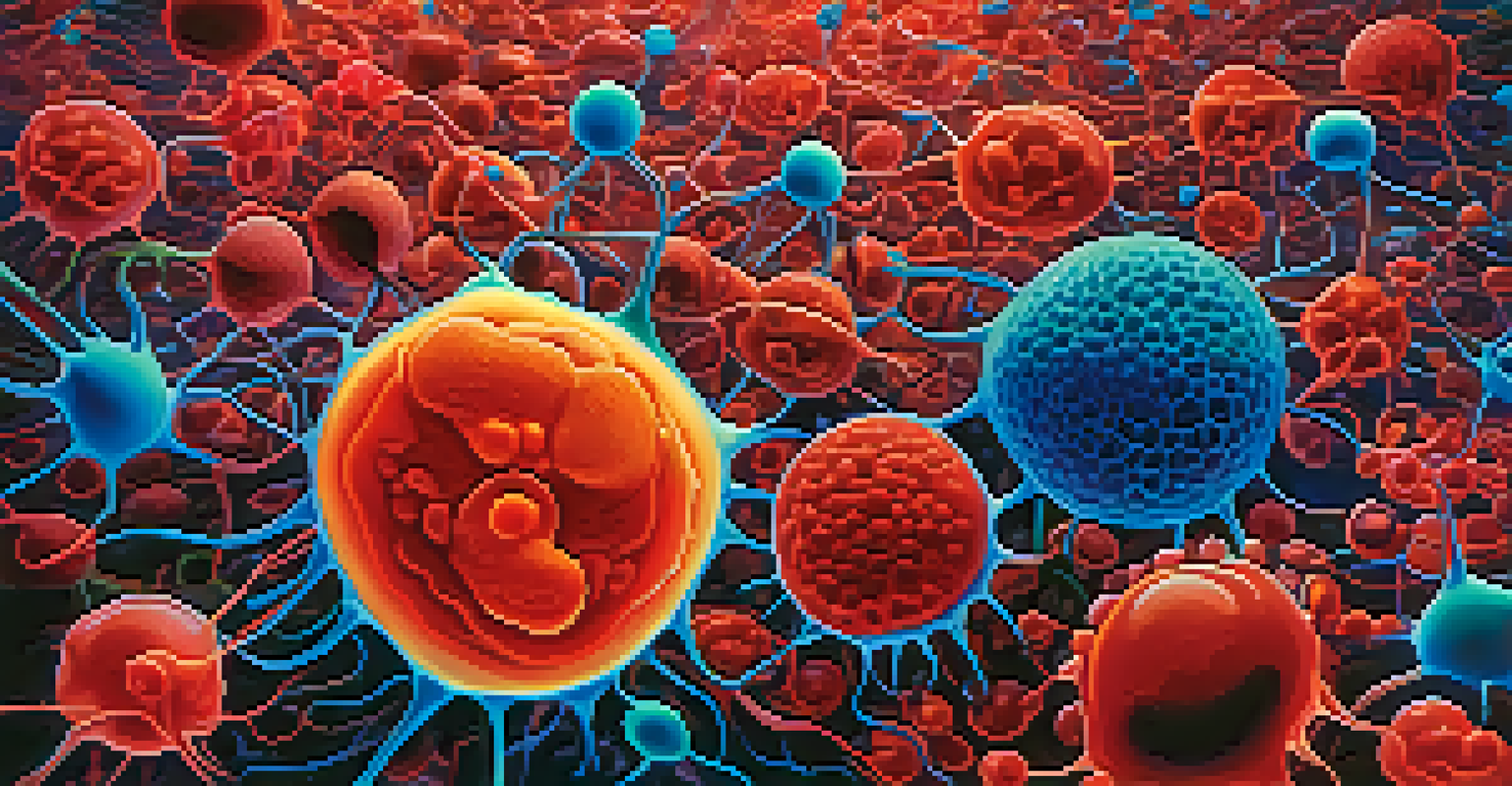Stem Cells and Their Role in Regenerative Medicine Today

What Are Stem Cells and Why Are They Important?
Stem cells are unique cells with the remarkable ability to develop into different cell types in the body. Think of them as the body's raw materials, ready to be molded into whatever is needed for healing and repair. Their capacity to regenerate damaged tissues makes them a focal point in medical research and treatment.
Stem cells are the building blocks of regenerative medicine, offering the potential to heal and repair damaged tissues.
There are two main types of stem cells: embryonic and adult. Embryonic stem cells come from early-stage embryos and can turn into any cell type, while adult stem cells are found in various tissues and are more limited in what they can become. This distinction is crucial in understanding their applications in regenerative medicine.
The potential of stem cells has sparked immense interest in the medical community, with researchers exploring their use in treating conditions like spinal cord injuries, heart disease, and even certain types of cancer. As we delve deeper, we uncover the exciting possibilities that stem cells hold for the future of healthcare.
How Stem Cells Work in Regenerative Medicine
In regenerative medicine, stem cells work by replacing or repairing damaged tissues. Imagine them as skilled workers in a factory, ready to take on various roles to restore functionality. Once introduced into the body, they can differentiate into specialized cells that promote healing.

For instance, in cases of heart disease, stem cells can be injected into damaged heart tissue, where they can generate new heart cells and help repair the damage. This process can improve heart function and enhance the quality of life for patients who suffer from chronic heart conditions.
Stem Cells: Key to Regenerative Medicine
Stem cells have the unique ability to develop into various cell types, making them crucial for healing and repairing damaged tissues.
Moreover, stem cells are not just about healing; they also play a significant role in understanding diseases. By studying how these cells behave in various conditions, researchers can gain insights into the mechanisms of diseases, paving the way for innovative treatments that target the causes directly.
Current Applications of Stem Cells in Medicine
Today, stem cells are used in various medical applications, most notably in treatments such as bone marrow transplants for leukemia patients. These transplants rely on hematopoietic stem cells, which are crucial for producing blood cells. This real-world application underscores the practical benefits of stem cell therapy.
The future of medicine will be personalized, and stem cells will play a crucial role in that transformation.
Beyond hematopoietic stem cells, researchers are investigating the use of mesenchymal stem cells for conditions like osteoarthritis. These cells, found in bone marrow and fat tissue, can regenerate cartilage and reduce inflammation, offering hope for patients suffering from joint pain.
The versatility of stem cells also extends to skin regeneration, where they are used in treating severe burns and wounds. By applying stem cells to these injuries, medical professionals can accelerate healing and improve skin regeneration, significantly enhancing patients' recovery experiences.
Challenges and Ethical Considerations in Stem Cell Research
While the potential of stem cell research is vast, it is not without its challenges and ethical concerns. The use of embryonic stem cells, in particular, raises questions about the moral implications of using embryonic tissue for research. This debate is ongoing and has led to strict regulations in many countries.
Another hurdle is the complexity of stem cell behavior. Scientists are still uncovering how to control stem cells effectively to ensure they differentiate correctly and don’t lead to unwanted side effects, such as tumor formation. This uncertainty makes the path to safe and effective treatments a bit rocky.
Current Uses of Stem Cells in Therapy
Stem cells are currently used in medical treatments such as bone marrow transplants and skin regeneration, showcasing their practical benefits.
Despite these challenges, the pursuit of understanding stem cells continues, driven by the potential benefits they hold for countless patients. Researchers are working diligently to navigate ethical concerns while unlocking the secrets of these remarkable cells, striving to make groundbreaking advancements in medicine.
The Future of Stem Cell Therapy
The future of stem cell therapy looks promising, with ongoing research aimed at expanding their applications. Scientists are exploring ways to harness induced pluripotent stem cells (iPSCs), which are adult cells reprogrammed to an embryonic-like state. This innovation could revolutionize the field by providing a source of stem cells without the ethical concerns associated with embryonic stem cells.
Moreover, advancements in gene editing technologies like CRISPR hold the potential to enhance stem cell therapies. By correcting genetic defects in stem cells before they are reintroduced into the body, researchers aim to create more effective treatments for genetic disorders, offering hope to many patients.
As we look ahead, the integration of stem cells into personalized medicine is another exciting frontier. By tailoring stem cell treatments to individual patients based on their unique genetic makeup, the effectiveness of therapies could soar, leading to better outcomes and a brighter future for regenerative medicine.
Real-Life Success Stories of Stem Cell Treatments
Numerous success stories underscore the transformative power of stem cell treatments. For example, patients suffering from severe spinal cord injuries have shown remarkable improvements after receiving stem cell therapy, regaining mobility and independence. These stories inspire hope and illustrate the potential of stem cells to change lives.
Another compelling case involves patients with degenerative eye diseases who have benefited from stem cell treatments that regenerate retinal cells. Many have experienced restored vision, demonstrating the real-world impact of stem cells on conditions once considered untreatable.
Future Prospects of Stem Cell Research
Ongoing research into stem cells and technologies like gene editing holds promise for personalized medicine and innovative therapies.
These success narratives not only highlight the efficacy of stem cell therapies but also emphasize the importance of ongoing research. Each story represents not just a personal victory but a testament to the hard work and dedication of scientists and medical professionals committed to pushing the boundaries of what is possible in medicine.
Conclusion: The Promise of Stem Cells in Regenerative Medicine
In conclusion, stem cells stand at the forefront of regenerative medicine, offering hope for a wide range of conditions. Their unique properties allow for innovative treatments that can repair and regenerate damaged tissues, providing a glimpse into a future where many diseases may be curable.
As research continues to unfold, the potential applications of stem cells are expanding, with advancements in technology paving the way for even more breakthroughs. The journey is not without its challenges, but the determination of scientists and medical professionals fuels the quest for solutions.

Ultimately, the promise of stem cells lies not just in their ability to heal but also in their role in shaping the future of personalized medicine. As we continue to explore the vast potential of these remarkable cells, we move closer to a world where regenerative medicine can enhance the quality of life for people everywhere.